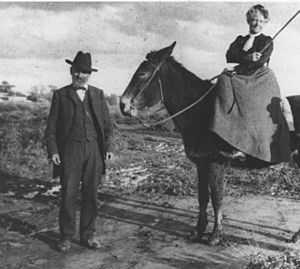Winfield Scott (chaplain) facts for kids
Winfield Scott (born February 26, 1837, died October 19, 1910) was an important American figure. He was a Baptist minister, a soldier, and a politician. After finishing his studies to become a minister, he joined the American Civil War. He led a group of soldiers.
He was hurt in battles and had to leave the army. After the war, he moved to Kansas. There, he helped a church grow and started new ones. He kept working as a minister in Colorado and California. Later, he became a chaplain for the U.S. Army. When he retired, Scott moved to the Salt River Valley. He helped found and promote the city of Scottsdale, Arizona. Even though he was a minister, he liked to be called "Chaplain, U.S.A." more than "Reverend".
Contents
Who Was Winfield Scott?
Winfield Scott was born on February 26, 1837, in West Novi, Michigan. His parents were James Burt and Margaret E. Scott. When he was a child, his family moved to Interlaken, New York.
Early Life and Education
Scott became a member of the Baptist church in February 1853. He studied at the University of Rochester and graduated in 1859. He then went to Rochester Theological Seminary, finishing in 1861. On July 13, 1859, Scott married Helen Louise Brown. They had four daughters together.
The "Fighting Parson" in the Civil War
After seminary, Scott became a pastor at a Baptist church in Syracuse, New York. In 1862, he left this job to join the American Civil War. He gathered a company of soldiers and became a Captain.
Scott was known as the "Fighting Parson." He led Company C of the 126th New York Volunteers. He was wounded during the Battle of Harpers Ferry. He was also hurt twice at Gettysburg and twice at Spotsylvania Court House. Because of his injuries, he had to leave the military on September 23, 1864.
A Minister's Journey
After the war, Scott became the pastor for the First Baptist Church in Leavenworth, Kansas. In six years, his church grew from 19 to 250 members. He also helped start churches in three nearby towns. The city of Winfield, Kansas, was even named after him. This happened after he promised to build a church there.
Spreading the Word in Kansas and Beyond
From 1872 to 1875, Scott served as a pastor in Denver, Colorado. In late 1875, he moved to California. There, he worked as an editor for a newspaper called Evangel. In 1877, he became a pastor in Los Angeles. The next year, he was an Associate Pastor in San Francisco. During that year, he also received a special degree called a Doctor of Divinity. Before 1880, Scott worked at churches in Petaluma and Oakland. In February 1880, he became a pastor in San Jose, California.
Becoming a U.S. Army Chaplain
In 1882, Scott became a U.S. Army Chaplain. He held this job until 1893. He first served at Fort Canby and Fort Stevens. In 1885, he moved to Angel Island.
Founding Scottsdale, Arizona
In February 1888, Scott visited the Salt River Valley in Arizona. Leaders there hoped he would help promote the area. Scott was very impressed. He bought 640 acres of land for US$2.50 per acre. This land was next to the Arizona Canal, which was almost finished.
In 1893, Scott moved to Fort Huachuca. He often visited his land. Meanwhile, his brother, George Washington Scott, moved to Arizona Territory. He cleared the land and started planting citrus trees. Scott himself moved to his homestead in 1893. He retired from the army on March 26, 1889, due to health problems from his old war wounds.
Scott was the first person to grow peanuts, citrus trees, and grapes in the Salt River Valley. He told everyone that the area was great for farming and as a health resort. A few years after Scott arrived, many families lived near his ranch. Scott and his wife started the Arizona Baptist Foundation. They became important leaders in the area. In 1896, a school was built, and the settlement around Scott's ranch was officially named Scottsdale.
Later Life and Legacy
Scott's influence went beyond just Scottsdale. In 1897, Governor Myron H. McCord made him the Chaplain of the Arizona National Guard. In 1899, he was elected to represent Maricopa County in the Arizona government. He tried to limit gambling and alcohol sales, but he was not successful.
From 1899 to 1900, Scott was a pastor at the Lone Star Baptist Church in Prescott. He also helped start churches in Naco, Arizona and Douglas, Arizona in 1902. In 1903, he was named the chief chaplain of the Grand Army of the Republic. Scott was also appointed to the Arizona Board of Regents in 1902 and became its chairman the next year. In 1906, he tried to get elected to the Arizona government again, but he did not win.
In 1909, Scott moved to San Diego, California. He became sick while in Phoenix, Arizona. He had surgery for a hernia shortly before he died on October 19, 1910. Winfield Scott was buried at Mount Hope Cemetery in San Diego. The Scott Memorial Baptist Church in San Diego (now Shadow Mountain Community Church) is named in his honor.


